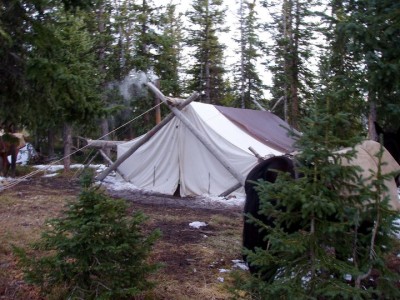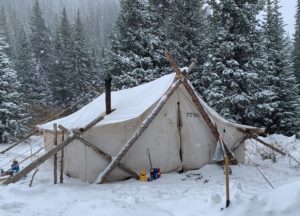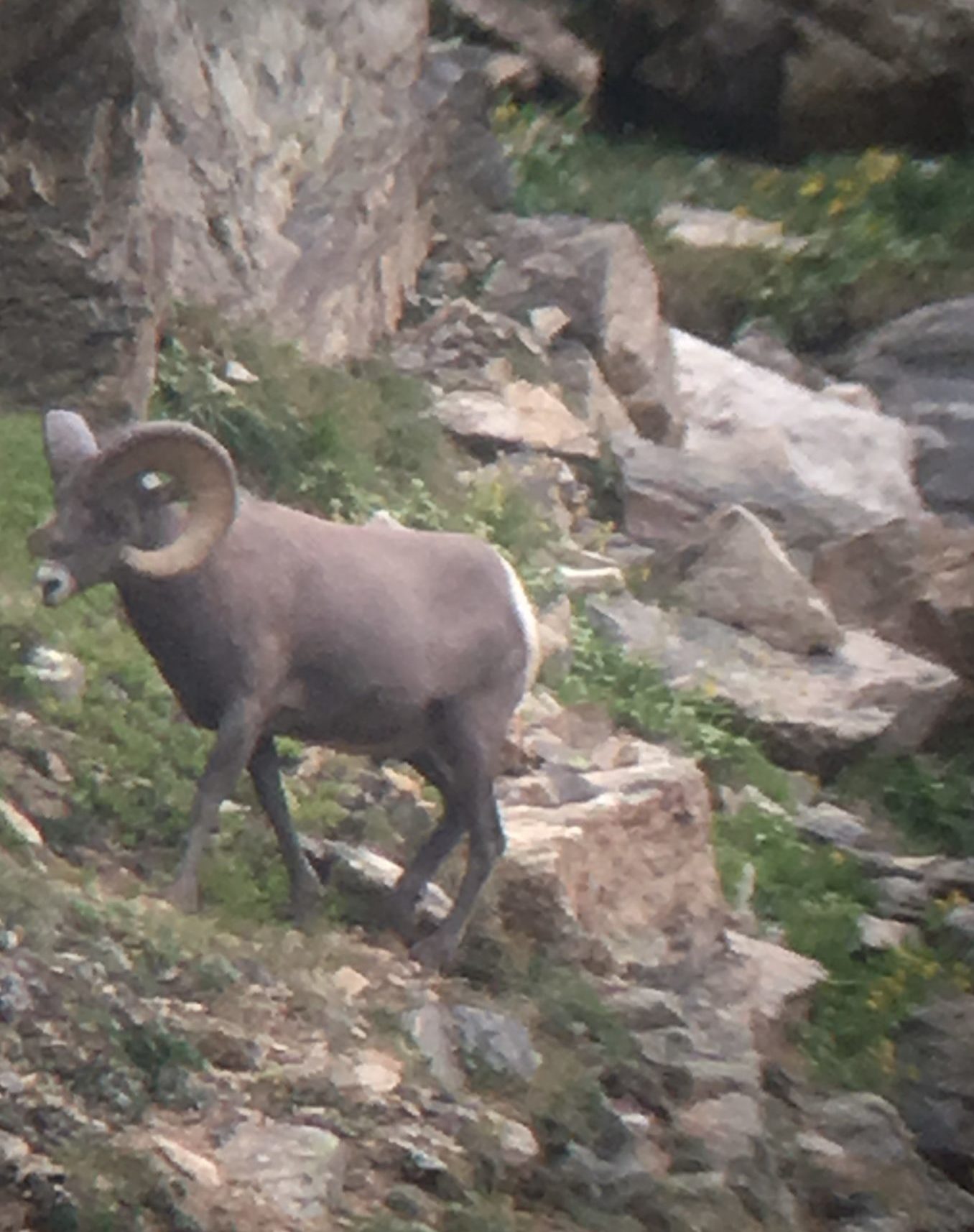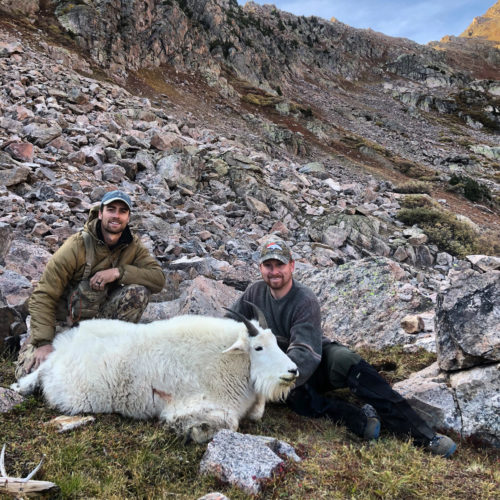I am a big proponent of DIY wilderness elk hunts. Say what! Yep, even as an outfitter I think people should mix in DIY hunts if they are capable. These hunts make you a better hunter, make you more resilient and can be a blast. They are a right of passage for the mountain hunter, particularly if done solo! On the more selfish side, past DIY hunters are some of the best clients because they appreciate the logistics and planning that goes into providing a good drop camp hunt in the Wilderness.
The discussion below compares DIY elk hunting with outfitted wilderness hunts. I also address a few misconceptions about both types of hunting.
This discussion assumes the definition of wilderness hunt is camping and hunting 3+ miles from any vehicle access for 7+ days.
Method 1, DIY with pack stock.
Excluding hunters that spend a large amount of money and time keeping stock year-round or individuals with years of livestock experience, doing a DIY hunt with rented horse or mules is not a good idea. A matter of fact, it is a horribly shitty idea. I have raised and rode horses for over thirty years. They are powerful creatures that constantly humble me to this day. Pack horses and mules ruin the hunt for more DIY hunters than probably anything else.
The problem is people don’t understand the difficulty in taking care of stock in the mountains. First, a horse needs 25lbs of good grass a day and a couple lbs of grain. That means after a good snow, you need to pack in hay or equivalent. In the Flat Tops Wilderness Area we are limited to feeding processed pellets. For a 5-7 day trip, that means 150lbs+ of feed per horse/mule. About as much weight as a horse can carry! Before the snow hits, you need to know how to turn horses out or picket them to graze. Horses and mules, including your sweet old family horse, are self preservationists. Horses get hungry or scared and run off when not cared for properly. Outfitters have the luxury of being able to take most the pack stock home while the hunting is done, bringing them back when you need them. Second, it takes a lot of time to saddle, turn out, catch, brush, feed, and water stock. One person will be caught up with these chores and never get to hunt. In our outfitted camps, if we are keeping horses to hunt off of, we are paying a dedicated wrangler to take care of things. Third, it takes one wrong move in the mountains for a horse to accidentally kill you. Stick a brow tine into the flank of a mule and you will have a 1,200 lbs of hoof imprinted in your face. Try to fix a pack saddle on a nervous horse going up a switchback and you might end up in the bottom of the drainage with that horse on top of you.
Llamas and goats are superior for the DIY hunt. The challenges with these animals are 1) deep and wet snow can kill them, 2) they are slow (your two feet can out pace them when they are packed), 3) you will need 4-6 per person to pack your elk and gear out; they just can’t carry much weight. If you have the patience and willingness to deal with these issues, they can be great companions and helpers on your DIY hunts. I know it sounds crazy, but the web is full of pack goat and llama packing enthusiasts. Many of these individuals have great DIY hunts with their stock.
As an aside, out of all services we outfitters try to provide, honest and strong stock is the most important. I believe it is the core reason outfitting exists and should continue to exist in our wilderness areas. Horse and mules get so many people out to enjoy the depths of these areas that would otherwise not be able to. If outfitting didn’t exist, a huge public asset would be only available to the mega rich or youth in prime physical shape.
[image_frame style=”framed_shadow” align=”center” title=”FTWG Pack Horses and Mules”]http://www.flattopswildernessguides.com/wp-content/uploads/2014/03/65319_358199854274252_1228922905_n1-e1395769588835.jpg[/image_frame]
DIY Method, Backpack Elk Hunting
After my father’s career as an outfitter was over and before I personally became an outfitter, I spent years backpack hunting past outfitter camps deep (3-8 miles) in road-less areas. I always thought to myself, “suckers!”. Now I realize that those hunters had a huge advantage over me. They woke up refreshed every morning to hit the hunt. They ate well and enjoyed the company of their friends. They knew they had help in case of an emergency. By the time I got up to my destination, I was beat and never really did enjoy myself. It was a personal mission to “kill” elk. I was proving something to myself. It wasn’t what enjoyable elk hunting is about. However, I do grant that backpack hunting taught me how to deal with extreme amounts of discomfort, a lot about deer and elk, and made me a more durable hunter and human in the mountains.
[image_frame style=”framed_shadow” align=”center” title=”DIY vs Backpack Hunting”]http://www.flattopswildernessguides.com/wp-content/uploads/2020/02/IMG_8012-scaled-e1580525366918.jpg[/image_frame]
Photo above is my brother and I with half a bull and a full camp on our backs, on a 6 mile hike out of a wilderness area.
Another point that can be painful to discuss is that, contrary to popular belief, success rates per day in the field for backpack hunts are much lower than outfitted hunts in the wilderness. How can I say that? First, I know a huge sample of backpack hunters in my area and all over the West. They just don’t harvest many animals for the amount of time they put in. Like I did, most of these hunters hunt a lot more days in the field than outfitted hunters. Compare the basics outline of a backpack trip vs a horse/mule drop camp and the reasons for this discrepancy are apparent:
Backpack:
Day 1) Pack in 40-50lbs of gear on your back and setup camp
Day 2) Opening day. Hunt very little because you can hardly move due to the soreness. Sleeping in a freezing-cold, ultralight tent, equates to not sleeping at all
Day 3) You’re already tired of eating freeze dried shit pie and ready to go home, but you do get some good hunting in
Day 4-5) You tough it out and spend a couple days hunting hard
Day 6) You destroy your spinal cord by packing out 250lbs of elk or you hobble down empty handed. You sleep at the trailhead, contemplating your unhealthy desire for pain
Day 7) You drive home. Over the following week you down a couple bottles of Tylenol.
Outfitted Drop Camp:
Day 1) Unload your truck at the outfitter’s pack station. Watch as each hunter’s pack animal is packed with up to 60lbs of food and 60lbs of gear per person. Jump on a sturdy mountain horse that knows the trails as good as the local elk. Enjoy the scenery on a 1-4 hour ride into camp. Go to bed in a warm, well equipped wall tent.
Day 2) Opening day. A little sore from the ride, wake up to prepare a hearty breakfast and be at a nearby meadow before light.
Day 3-5) You’re eating well and keeping your energy level up. Hiking 2-3 miles a day on fresh legs, you are starting to understand the area and getting into elk on a daily basis.
Day 6) You make the best of an opportunity and manage to kill a bull. You quarter the bull with a partner and call the outfitter on your satellite phone.
Day 7) The outfitter shows up at first light to pack out your bull and help get things ready for your ride out. As the outfitter heads down with the elk and some gear, a wrangler shows up with your riding horses and a couple more mules. A short ride out, gear thrown in the truck, and you’re on your way home.
Myths About Outfitted Elk Drop Camps and Guided Hunts
The biggest points of opposition I get on this subject: 1) I just like doing things myself. I like to hunt elk my way. I like to do my own calling. I don’t want some guide calling the shots. I like the challenge of doing it on my own. 2) Outfitter camps limit your mobility and elk are always on the move!
Regarding #1, you can be as independent as you want when using an outfitter for a drop camp or full service hunt. Just be straightforward with your outfitter when buying a full service (guide, cooking, horses during hunt and camp) hunt. They may have some feedback on how you want to do things and how it might affect your shot opportunities. They should take into account your preferences or they aren’t doing their job for you. If they say that their guides are the best elk hunters in the world and you better listen, just go elsewhere. Our guides are here to help you. They know the area and elk well. They are not masters of the elk hunting universe.
Drop camps are a more natural option for independent clients. If you have someone in your group that likes cooking for the team, they can be a fantastic option. Drop camps save you a little cash, also!
On the “I want a challenge” note, I promise you that you will be challenged on this hunt if you want to be. I don’t care if you are a 20 time marathon runner or a navy seal, mountains at 10-11K elevation will kick your ass if you put out a strong effort for a five day hunt. Outfitters allow you to take that energy and focus it on the actual goal. You avoid the “logistics” part. I love guys that hit it hard and cover 4-5 miles a day. Guys like that on DIY hunts waste a lot of time on pack train trails carry tons of equipment on their back while dozens of horses pass them by. When they hunt with us, they learn areas quickly and are constantly into elk.
Regarding #2, outfitter camps limit your mobility and elk are always on the move. I think this one was started by a bunch of people who “conceptually” hunt elk. They don’t actually hunt much, but if they did they think it would be like this. They spend most their time on hunting forums making shit up. Moving around your camp every day to “get into elk” is borderline insane. Not to mention it is a physical impossibility for 99% of DIY hunters, even with the lightest weight gear. Outfitters actually could move camps periodically, but the good ones know it just wastes precious hunting time and disrupts the game in the area.
In archery season, high country elk rut in the same areas (rubbing literally the same trees) year after year. Most good outfitters, including us, have dedicated archery camps near these areas. These areas hold 95% of the elk and are probably less than 10% of the land area. You can be mobile in the 90% elk barren waste land, but it won’t help. Hunting historic rutting grounds is how archers kill elk, not constantly moving through areas.
Elk do move in a huge way during the rifle seasons. I’d argue that after the first shot, THEY CONSTANTLY MOVE. When hunters aren’t moving them, the weather is. We put our rifle camps (yes, drop camps too) into areas that have historically been elk transition areas. We know the exact meadows elk move through and the exact timber they linger in until pushed out. At any given time, there are elk still above our camps and elk that are already below our camps. You might not have sign around you one day, and wake up to a 100 sets of tracks the next morning. Following animals down elevation or up while dragging a bunch of gear just pushes them. You are better off hunting in a 2-4 mile radius circle and learning the ground well for when you find elk or the elk show up. Success does not come from marathon hikes with bivouac gear and trying to sleep with the herd. Go back and sleep in a nice tent. Elk can move over 3 miles in a night. Thus, it’s just as likely that in the morning the elk will be outside your wall tent as it is they will be in the same spot as the night before.





Just wanted to let you know I enjoyed your article. I live and hunt in WY and have hunted in your area before and laughed to myself about your thoughts and experiences. Couldn’t have said it better myself!
Fantastic! Great info garnered from years in the field. I am 61 and have guided a large amount of that time in Western Co..Handling horse,mule,feed has a far greater chance of injury than staying in a bear den.
Also you people who are reaching my age,let your ego go and do drop camps. I am doing my last back country back pack hunt this year,and look forward to letting someone else tip over backwards carrying elk out on my back.
Great article! It seems to follow the progression of many DIY Elk hunters. I hunt with guys I served with in the military. We have tried several types of elk hunts, starting with large outfitter tent near the trailhead and hiking in, Horseback drop camp, DIY horse rental, this year I transported 2 horses from Tennessee and we packed them in with our lightweight gear. I high lined them for a 5 day hunt. Things I learned, Should have brought horse blankets (it got very cold), Should have had a 4 season bag, and tent, I got very cold! Gotta make 2-3 trips 1st day in before the hunt starts, to transport the feed for the horses. Plus the initial trip with all the gear. Tiring each way 5 miles. (dangerous too) Then , you have to water morning and night, feed and make sure the high line is correct and taught. We did score a large bull, and the horses were great value getting it out, and back to the truck. 2 trips 5 miles each way alone, dangerous. 20 miles total in a day. So the guy that takes care of the horses gets much less hunt time and the work load is even greater for him. 20 hour drive from Tennessee, you have to water the stock several times, and make sure they are ok, plus the return trip. Drop camp is much more relaxing and agree with the article, you get more hunting done! I love my horses, and would do it again, because I am one of those stubborn independent types, but the pain is still fresh 2 months removed, so a drop camp is sounding good next year, That of I forgo most of the hunting, and stay in camp and wrangle, cook and drink beer! Oh yea, you gotta pack that in too, !!!HAHA
Interested in 2023 or 24 hunt